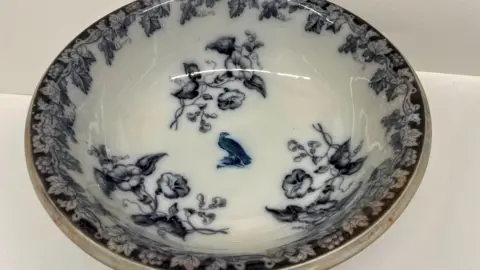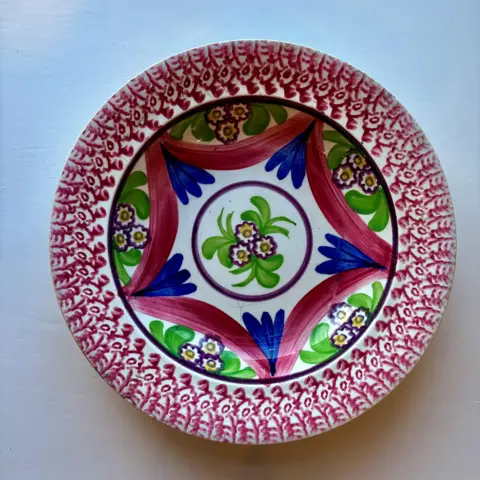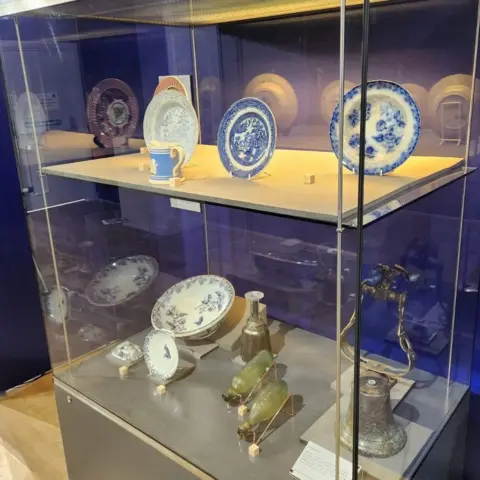Public to see Arran shipwreck pottery for first time
 Scottish Maritime Museum
Scottish Maritime MuseumPieces of rare 19th Century pottery - which were recovered from a shipwreck off the coast of Arran - are to go on display for the first time.
The ceramics were discovered by diver Graeme Bruce, 65, from Oban in the wreck of the SS Eagle, a mile from Lamlash Bay, last July.
The ship - an early steamboat - was heading to Ireland when it sank in 1859 after colliding with another vessel. Eleven people died.
Several artefacts made by the Glasgow-based Bell's Pottery will appear in the Scottish Maritime Museum's Summer exhibition which opens in Irvine on Saturday.
Graeme, a retired engineer, and the team of seven other divers, were 53 metres beneath the surface when they spotted the treasure trove of rare pottery.
Most of the ship had rusted away but the cargo was lying well preserved in the mud.
In the 19th century, Glasgow was a major centre for the production of ceramics and rivalled the Staffordshire potteries.
Bell's Pottery is recognised as arguably the most internationally significant producer of ceramic wares in Scotland at the time.
The haul on the SS Eagle is an unprecedented example of an almost intact cargo of 19th century Glaswegian ceramics.
 Scottish Maritime Museum
Scottish Maritime Museum Scottish Maritime Museum
Scottish Maritime MuseumThe SS Eagle's ceramics cargo was destined for trade and exhibition in Londonderry.
Exhibits include seven plates and a bowl, a teapot lid and two bottles which still hold 'sparkling water' in addition to a decanter and bell.
Eva Bukowska, exhibitions and events officer at the Scottish Maritime Museum, said: "We are really excited to host the first showing of these fascinating ceramics recovered from SS Eagle.
"The vessel also has a significance for the museum as it was built by Alexander Denny, who was the brother of William Denny, whose test tank is now home to our second collection in Dumbarton."
 Scottish Maritime Museum
Scottish Maritime MuseumGraeme Bruce said: "Diving has been my great passion for 35 years.
"For me, a shipwreck is a 'time capsule' hidden from view over time by the sea. The privilege of being able to explore and connect with the past is beyond description.
"Enabling the artefacts from shipwrecks like this Bell's Pottery collection to then have a new life on show for everyone to learn from and appreciate is so important.
"Connecting people with a heritage like this means everything to me and those I dive with."
The SS Eagle launched from the Dumbarton yard of Alexander Denny in July 1857.
The 324-tonne steamer was acquired by the McConnel and Laird Line of Glasgow in June 1859 for service as a passenger and cargo vessel.
Just five months later, on 28 November 1859, SS Eagle sank after colliding with a sailing ship, the Pladda, whilst en route from Glasgow to Londonderry with a general cargo, 200 sheep and 54 passengers.
According to the Scottish Pottery Society, Bell's Pottery export wares have been found as far afield as South America, the Far East, Australia and Canada.
The last piece of Bell's Pottery was probably made around 1912.
The Beneath the Waves exhibition, in the museum's Linthouse building in Irvine, also features award-winning underwater photography and an artist's detailed marine sketches.
It runs from Saturday 7 June to Saturday 13 September.
